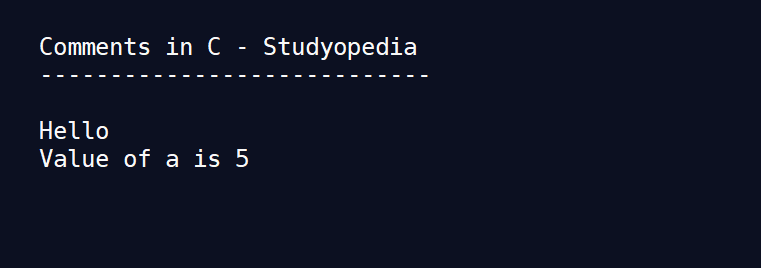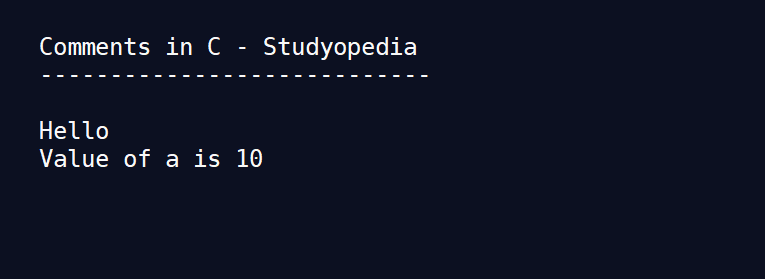17 Oct Comments in C Language
Comments in C language are used to provide extra details about various aspects of a program. They are usually included at the start of a program to indicate its purpose, its author, and the date on which it was written. They also provide clarification about complicated statements in the program.
Before moving further, we’ve prepared a video tutorial to understand what are comments in C:
There are two types of comments used in C. These are single-line comments and multi-line comments. Details about these are given as follows:
Single Line Comments
These comments are only on a single line and cannot move beyond that. They are represented using a double slash (//). An example of single-line comments in C is:
|
1 2 3 4 5 6 7 8 9 10 11 12 13 14 15 16 17 18 19 |
// Program to display single line comments // Studyopedia - Never Stop Learning #include < stdio.h > int main(void) { int a = 5; printf("Comments in C - Studyopedia\n"); printf("\n----------------------------\n"); printf("Hello\n"); // Printing Hello on screen printf("Value of a is %d", a); // Printing value of a return 0; } |
The output of the above program is:

Multi-Line Comments
These comments can be extended over multiple lines. They are represented using /* i.e slash asterisk (/*……….*/). Multi-line comments cannot be nested. An example of multi-line comments in C is:
|
1 2 3 4 5 6 7 8 9 10 11 12 13 14 15 16 17 18 |
/* Program to display multi-line comments Studyopedia - Never Stop Learning */ #include < stdio.h > int main(void) { int a = 10; printf("Comments in C - Studyopedia\n"); printf("\n-------------------------\n"); printf("Hello\n"); printf("Value of a is %d", a); return 0; } |
The output of this program is:

If you liked the tutorial, spread the word and share the link and our website Studyopedia with others:
For Videos, Join Our YouTube Channel: Join Now
Read More:


No Comments